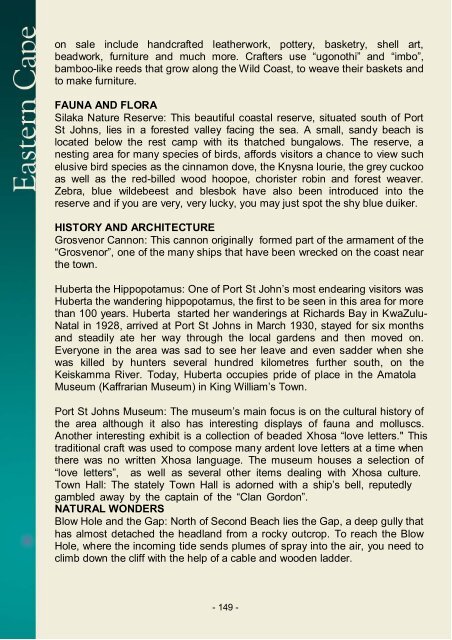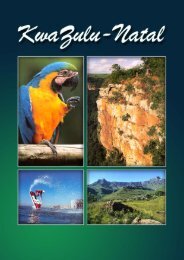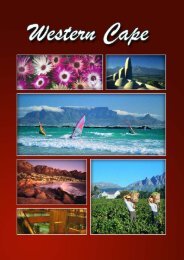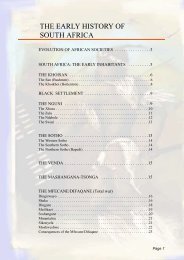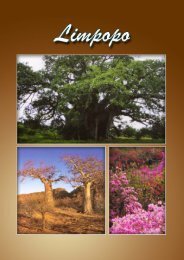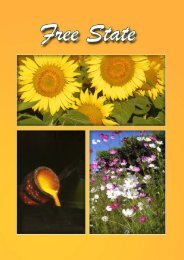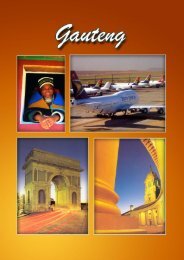Eastern Cape Provincial Article - South African Vacations
Eastern Cape Provincial Article - South African Vacations
Eastern Cape Provincial Article - South African Vacations
You also want an ePaper? Increase the reach of your titles
YUMPU automatically turns print PDFs into web optimized ePapers that Google loves.
on sale include handcrafted leatherwork, pottery, basketry, shell art,<br />
beadwork, furniture and much more. Crafters use “ugonothi” and “imbo”,<br />
bamboo-like reeds that grow along the Wild Coast, to weave their baskets and<br />
to make furniture.<br />
FAUNA AND FLORA<br />
Silaka Nature Reserve: This beautiful coastal reserve, situated south of Port<br />
St Johns, lies in a forested valley facing the sea. A small, sandy beach is<br />
located below the rest camp with its thatched bungalows. The reserve, a<br />
nesting area for many species of birds, affords visitors a chance to view such<br />
elusive bird species as the cinnamon dove, the Knysna lourie, the grey cuckoo<br />
as well as the red-billed wood hoopoe, chorister robin and forest weaver.<br />
Zebra, blue wildebeest and blesbok have also been introduced into the<br />
reserve and if you are very, very lucky, you may just spot the shy blue duiker.<br />
HISTORY AND ARCHITECTURE<br />
Grosvenor Cannon: This cannon originally formed part of the armament of the<br />
“Grosvenor”, one of the many ships that have been wrecked on the coast near<br />
the town.<br />
Huberta the Hippopotamus: One of Port St John’s most endearing visitors was<br />
Huberta the wandering hippopotamus, the first to be seen in this area for more<br />
than 100 years. Huberta started her wanderings at Richards Bay in KwaZulu-<br />
Natal in 1928, arrived at Port St Johns in March 1930, stayed for six months<br />
and steadily ate her way through the local gardens and then moved on.<br />
Everyone in the area was sad to see her leave and even sadder when she<br />
was killed by hunters several hundred kilometres further south, on the<br />
Keiskamma River. Today, Huberta occupies pride of place in the Amatola<br />
Museum (Kaffrarian Museum) in King William’s Town.<br />
Port St Johns Museum: The museum’s main focus is on the cultural history of<br />
the area although it also has interesting displays of fauna and molluscs.<br />
Another interesting exhibit is a collection of beaded Xhosa “love letters." This<br />
traditional craft was used to compose many ardent love letters at a time when<br />
there was no written Xhosa language. The museum houses a selection of<br />
“love letters”, as well as several other items dealing with Xhosa culture.<br />
Town Hall: The stately Town Hall is adorned with a ship’s bell, reputedly<br />
gambled away by the captain of the “Clan Gordon”.<br />
NATURAL WONDERS<br />
Blow Hole and the Gap: North of Second Beach lies the Gap, a deep gully that<br />
has almost detached the headland from a rocky outcrop. To reach the Blow<br />
Hole, where the incoming tide sends plumes of spray into the air, you need to<br />
climb down the cliff with the help of a cable and wooden ladder.<br />
- 149 -


